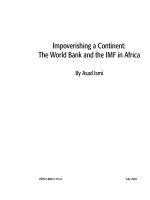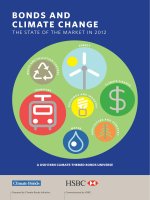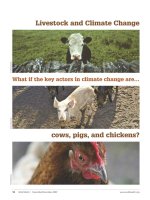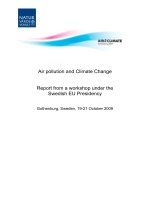BONDS AND CLIMATE CHANGE THE STATE OF THE MARKET IN 2012 pdf
Bạn đang xem bản rút gọn của tài liệu. Xem và tải ngay bản đầy đủ của tài liệu tại đây (1.38 MB, 8 trang )
A USD174BN CLIMATE-THEMED BONDS UNIVERSE
A
G
R
I
C
U
L
T
U
R
E
A
N
D
F
O
R
E
S
T
R
Y
C
L
I
M
A
T
E
F
I
N
A
N
C
E
E
N
E
R
G
Y
W
A
T
E
R
W
A
S
T
E
A
N
D
P
O
L
L
U
T
I
O
N
C
O
N
T
R
O
L
B
U
I
L
D
I
N
G
S
A
N
D
I
N
D
U
S
T
R
Y
T
R
A
N
S
P
O
R
T
BONDS AND
CLIMATE CHANGE
THE STATE OF THE MARKET IN 2012
Prepared by Climate Bonds Initiative. Commissioned by HSBC.
Bonds will play a crucial role in financ-
ing the transition to a low-carbon,
climate-resilient economy. Investor
interest in the asset class is growing,
but what is the current investment
opportunity already out there?
This report, commissioned by the
HSBC Climate Change Centre of
Excellence and prepared by the
Climate Bonds Initiative, presents
a first estimate of the outstanding
global bond market size linked to
key climate change themes, and
examines future drivers and trends
in the short term.
In spite of the financial crisis,
institutional investor commitment
to action on climate change has
grown not fallen. Back in 2009 at the
Copenhagen climate summit, 187
institutions with over USD13trn in
assets under management (AUM)
supported a statement asking for
robust policy action. By the time of the
2011 Durban conference, this backing
had increased to 285 institutions with
over USD20trn in AUM.
Importantly, this call for clear
policy and market frameworks that
The time has come to mobilise bonds
for climate investment
enable investments in low-carbon
growth is moving from the high-level
policy arena to the details of asset
allocation. At Durban, a group of
leading insurers with AUM of more
than USD3trn specifically called for
“a significant increase in global bond
issuance to be dedicated to finance
for an acceleration of the transition
to low-carbon growth”
1
.
Sizing the bond universe
This report aims to deepen the
current understanding of the
climate-themed bond market by
addressing four key questions:
• How big is this market?
• What are the key investment
themes?
• Where are the main regional
markets?
• What is the market outlook?
The global bond universe was
screened for climate change
solutions in seven key themes:
energy; transport; buildings and
industry; finance; waste; water; and
agriculture and forestry. Only bonds
issued since 2005 were included as
2 Bonds and Climate Change www.climatebonds.net June 2012
this is the year the Kyoto Protocol
came into force and the climate
change agenda gained prominence.
The use of proceeds for the
bonds identified was analysed
and supplemented primarily by
revenues for corporate issuers or
other factors such as the generation
mix of utilities. Bonds were then
assigned to categories based on the
relative strength of their alignment
with climate themes. Fully dedicated
bonds were classified as ‘climate-
themed bonds’.
1 Climatewise, Call to increase opportunities to make low-carbon fixed
income investments, December 2011
“Investor
interest in the
links between
bonds and
climate change
is growing”
Why bonds and
climate change?
Bonds are particularly suited for
providing the capital for the long-term
environmental infrastructure required
to build a low-carbon, climate-
resilient economy. The extra upfront
investments are often balanced
by much lower operating costs,
particularly in the building, energy,
industrial and transport sectors.
It is estimated that around USD10trn
in cumulative capital investments will
be required globally between 2010
and 2020 to drive low-carbon energy
alone
2
. The historical 60:40 split
between debt and equity means that
cUSD6trn could be required in terms
of bank loans as well as bonds.
The success of climate policies has
meant that key clean technologies
are now reaching a stage of
maturity appropriate for greater
bond investment. From a regulatory
perspective, new financial regulations
(such as Basel III) could result in a
shift to more capital-market funding
of project finance transactions. Basel
III could discourage banks from
holding longer-term loans on their
balance sheets, prompting increasing
costs, reductions in the term of loans
and introducing greater refinancing
risk.
3
In addition, changing asset
allocation strategies are generating
greater demand from investors such
as pension funds and insurance
companies who need long-term
fixed-income investments to match
their liabilities.
Finally, institutional investors
are extending the integration of
sustainability factors beyond listed
equities into other asset classes,
creating appetite for bonds linked to
climate change.
2 HSBC, Sizing the Climate Economy, September 2010
3 See Standard & Poor’s, Basel III and Solvency II regulations could Bring
a sea Change in Global Project Finance Funding, 14 October 2011
3 Bonds and Climate Change www.climatebonds.net June 2012
There are some USD174bn in over
1,000 climate-themed bonds
4
outstanding from 207 issuers.
Corporates – included listed, state-
owned and private companies –
account for 82% of the total, followed
by development banks and financial
institutions (13%), project bonds
(3%) and municipal bonds (2%).
CONDITIONALLY
ALIGNED:
bonds from issuers whose contribution
to the climate economy is conditional
on factors such as feedstock, size, and
specificity of activities.
At USD174bn, a broad and deep universe
FULLY ALIGNED:
bonds that are labelled green/climate
and bonds from issuers or projects
which are wholly dedicated to
climate-related activities;
$204
BILLION
STRONGLY
ALIGNED
$373
BILLION
CONDITIONALLY
ALIGNED
Beyond this core universe, we believe
that there could be another cUSD204bn
of outstanding bonds from issuers
with more than 50% of revenues and
activities linked to the climate economy.
In addition, we also identified a further
cUSD373bn of bonds as ‘conditionally-
aligned’. These are from sectors or
technologies that are core to the climate
economy, but where more disclosure
is required to determine which bonds
should be included in our universe.
Examples Include biofuels, hydro, waste
and water. More transparency from
issuers could bring some of these into
the climate-themed bond universe.
4 Calculated as of February 2012 with only amounts outstanding from
bonds issued since 2005
Climate-themed bonds Where future growth could come from
STRONGLY-ALIGNED:
bonds from issuers that have
revenues or other relevant metrics
greater than 50% dedicated to
climate-related activities.
82%
Corporate Bonds
Source: Climate Bonds Initiative, HSBC, Bloomberg
13%
Financial Bonds
3%
Project Bonds
2%
Municipal Bonds
$174
BILLION
CLIMATE-
THEMED BONDS
4 Bonds and Climate Change www.climatebonds.net June 2012
Buildings and Industry:
• Includes technologies and projects
designed to improve the energy
eciency of buildings and industry.
• Majority of the cUSD1.5bn climate-
themed bonds issued by LED manufacturers.
• USD691m of US municipal bonds issued through
a range of initiatives to retrofit residential and
commercial buildings.
• Large corporates such as GE, Schneider Electric and
Siemens have an opportunity to issue asset-linked
bonds to be included in the universe.
Water:
• We screened for sustainable
climate-resilient water
management systems, technologies
and infrastructure.
• USD196bn of bonds issued by water utilities and US
municipals deemed conditionally-aligned.
• Issuers could link bonds more clearly with water
conservation and flood prevention measures.
Transport:
• Includes transport modes with
relative carbon eciency as well
as manufacturers of low-carbon
biofuels and vehicles.
• Rail is the largest constituent accounting for over
95% of climate-themed bonds.
• Rail is included for its clear carbon outperformance:
in the UK, rail is 40% as carbon-intensive as
conventional gasoline automobiles, and at least four
times less carbon-intensive than heavy trucks for
freight transport.
• Coal freight was excluded where explicit.
• Growth expected as sales of fuel-ecient, hybrid
and electric vehicles increase and electric vehicle
infrastructure expands.
Energy:
• Fully aligned activities include:
renewable energy sources, nuclear
and biomass for heat and electricity.
• Bonds linked to large hydropower in
tropical regions not included due to potentially high
carbon footprints.
• Bonds linked to the expansion of wind and solar
power account for two-thirds of the USD29bn in
energy bonds.
• Large corporates including Sunpower, Solarworld,
Goldwind, Sinovel and Suntech have issued
cUSD1.5bn in the past year.
• Project bonds make up 20% and include Topaz
Solar Farm, Genesis Solar, Desert Sunlight, Alta
Wind and Shepherds Flat.
Climate Finance:
• Climate-themed bonds dominated
by the ‘green’ labelled programmes
of MDBs (USD7.2bn), and Eurofima
(USD15bn).
• MDBs with labelled bond programmes include
Asian Development Bank, European Investment
Bank and the World Bank as well as Norway’s
Kommunalbanken and India’s Renewable Energy
Development Agency.
• The insurance sector could play a dual role both as
an institutional investor and as an issuer.
Waste and Pollution
Control:
• Includes companies providing
recycling services or recycled
products as well as filters and end-of-pipe GHG
emission reduction systems.
• Climate-themed bonds are calculated at USD1.2bn.
• USD163bn of conditionally-aligned issuance is from
US municipals designated for ‘pollution control’.
• Growth expected in bonds for waste-to-energy
technology.
Agriculture and Forestry:
• Includes paper and wood product
manufacturers, forest management
companies and organic seeds and
fertilizers.
• USD730m of climate-themed bonds identified.
• Very few bond-issuing companies generate 100% reve-
nues from sustainable agriculture and forestry practices.
• No bonds linked to halting tropical deforestation
exist yet.
Bonds across the Climate Economy
BUILDINGS AND
INDUSTRY
The climate-themed bond universe is
dominated by the transport and en-
ergy sectors, which together make up
85% of the total. Beyond the climate-
themed bonds, there are baskets of
other bonds that represent future
expansion if the proceeds were clearly
dedicated for low-carbon, climate-re-
silient purposes such as in the energy,
waste and water themes.
Broader and deeper than expected
What is significant about these
findings is that they present a climate-
themed bond market that is both
broader and deeper than expected.
The reality is that the transition to a
low-carbon, climate-resilient economy
will develop on the back of key parts of
current infrastructure (such as rail and
Low-carbon transport and energy account
for the bulk of issuance
water), supplemented by extensive
additional investment in low-carbon
energy, eciency improvements
in buildings and industry as well as
sustainable forests and agriculture.
This report thus re-frames the
scope of the investable universe for
climate-themed bonds – and could
help to overcome perceptions among
investors that this market is niche and
lacking both scale and liquidity.
In the pipeline
We expect further growth in the
climate-themed bond market over
the coming year. Indeed, a number of
bonds were issued between our cut-o
date of February 2012 and publication.
Key trends to watch include:
• a broader range of issuance from
public finance institutions, such
as the recent ZAR5.2bn bond
from South Africa’s Industrial
Development Corporation.
• progress in resolving the regulatory
obstacles to the concerns over
PACE bonds in the USA. The value
of PACE bonds could grow to an
annual USD12bn market over the
next decade – if current regulatory
issues are resolved
5
.
• growth in the project bond market
building on market momentum in
the USA and, potentially the EU’s
project bond initiative.
• expansion in the corporate bond
market particularly from energy
utilities and industrial energy
eciency corporates.
5 Johnson Controls, Institute for Building Eciency, 2010
Figures in USD Billions
TRANSPORT
ENERGY
CLIMATE FINANCE
WASTE AND
POLLUTION CONTROL
AGRICULTURE
AND FORESTRY
Conditionally-
aligned
Strongly-
aligned
Fully-
aligned
WATER
130 66
47 197 2163
2
11929 1221
60
1
5 Bonds and Climate Change www.climatebonds.net June 2012
Source: Climate Bonds Initiative, HSBC, Bloomberg
Across the regions
UK institutions have issued the largest
amount of climate-themed bonds,
with 23% of the global total. France
comes in second with 17%. Together,
Europe accounts for 67% of the global
market, followed by the USA (17%),
and Russia, Canada and China all at
around 3% each.
UK
FRANCE
UNITED STATES
SWITZERLAND
GERMANY
RUSSIA
CANADA
CHINA
Total Investment
Climate-themed Bonds
USD Billions
40
30
20
10
0
6 Bonds and Climate Change www.climatebonds.net June 2012
Europe: largest issuance
Europe’s leading position
in climate-themed bonds is
explained by the large volume
of outstanding issuance for
rail infrastructure. But large
utilities are now starting to tap
the bond market to finance
the expansion of renewable
energy. In the climate-themed
universe, the most notable
project bond issuance was
the partially-guaranteed
USD260mn Andromeda solar
bond, issued at the end of 2010.
The European Union has also
established a project bond
initiative to channel public
funding into the enhancement
of credit ratings for energy,
transport and ICT infrastructure.
USA: project bond leadership
The USA is the 3rd-highest issuer
of climate-themed bonds, with the
municipal market being a key fea-
ture. We expect US States will issue
public revenue bonds to finance fur-
ther investments in water resource
management with necessary
climate resilience measures such as
planning, flood control and waste-
water treatment. Capital for clean
energy will be also be a priority. The
solar project bond market could
grow on the back of the successful
Topaz oering – a USD850m bond
issued in 2012 with no government
guarantees. However, a promising
market in Property-Assessed Clean
Energy (PACE) bonds is currently
slowed by a Federal Housing Fi-
nance Agency ruling.
Brazil: expansion ahead
Climate-themed bonds from
Brazilian issuers amount to
approximately USD1bn. In future,
Brazil’s national development
bank (BNDES) could be at the
forefront of climate-themed bond
investment. In February 2012,
BNDES launched lines of credit for
the Brazilian Climate Fund with
subprograms including ecient
transport modals, ecient
machinery and equipment,
non-hydro renewables, waste-
to-energy plants, and combating
desertification. Bonds for
forest conservation backed by
REDD carbon credits or local
governments are being explored
but are unlikely to be available in
the short-term.
7 Bonds and Climate Change www.climatebonds.net June 2012
Japan: a key source of demand
We estimate that Japan has
around USD1bn in climate-
themed bonds. But Japan plays
another important role – as a
source of demand for ‘green’
labelled bonds from multilateral
development banks. Japanese
underwriters and arrangers
have been prominent in the
issuance by World Bank, IFC,
EIB and EBRD bonds targeting
domestic ‘Uridashi’ retail
investors. New domestic
issuance is also likely as
the government announced
discussion to legally establish
the debt seniority of corporate
bonds from renewable
electricity providers ahead of
other unsecured debt.
China: low-carbon
growth potential
A growing renewables sector
has contributed 80% of its total
of USD6bn. Local issuance by
renewable energy companies
increased fourfold in 2011 to
USD4.3bn. The oshore renminbi
bond market in Hong Kong could
see future issuance from state-
owned rail companies as well as
being tapped by large energy con-
servation groups and renewable
manufacturers. Four local govern-
ments – Guangdong, Shanghai,
Zhejiang and Shenzhen – have
also received the green light to
pilot municipal issuance this year,
pointing towards opportunities of
linking low-carbon city develop-
ment to the bond market.
South Korea: green growth
Although currently ranked only
20th in the current climate-themed
bond universe, South Korea
represents an innovative market
for future growth. In 2009, the
government launched its five-year
Green Growth plan which targets
spending at 2% of GDP and
provides incentives for companies
certified as having 30% of sales
from green technologies or projects.
To date 66 companies have
achieved certification
6
– investors
in these companies also receive
tax incentives
7
. This opens up
opportunities for investors to gain
exposure to cleantech sectors such
as fuel-cells and electric vehicles.
JAPAN
•
$0.58 bn
•
$0.62 bn
US
•
$8.37 bn
•
$1.11 bn
•
$3.20 bn
•
$14.64 bn
•
$0.26 bn
CHINA
•
$4.99 bn
•
$1.13 bn
FRANCE
•
$1.29 bn
•
$29.08 bn
UK
•
$0.44 bn
•
$39.95 bn
•
$0.06 bn
GERMANY
•
$2.32 bn
•
$11.50 bn
•
$0.25 bn
•
$0.16 bn
•
$0.01 bn
6 www.greencertif.or.kr
7 OECD, Korea’s green growth strategy, August 2011
KEY
•
Energy
•
Transport
•
Climate Finance
•
Buildings and industry
•
Waste and Pollution Control
•
Agriculture and Forestry
Source: Climate Bonds Initiative, HSBC, Bloomberg
,
Growing the market requires
standardisation and aggregation
This report has identified a climate-
themed bond market that is both
broader and deeper than expected.
Issuance of climate-themed bonds
is continuing in key regions. But
innovative solutions are needed if we
are to finance the transition to a low-
carbon, climate-resilient economy.
Below are three key ways of
accelerating investor engagement and
market expansion.
1. Standardise and certify
Clear market norms build confidence.
Third-party certification of climate-
themed bonds based on agreed
standards could both reduce
reputational risks and enable market
liquidity. It would also make positive
screening easier for those investors
concerned with the macro risks of
climate change. From this report, key
priorities would be the waste and
water sectors.
2. Aggregate to scale and index
Tapping the institutional investment
market requires suitable deal flow,
with sizes over USD500mn. Currently,
we have identified 103 bonds over
this threshold (77 transport, 11 energy
and 14 finance). Aggregation vehicles
are therefore required in order to
refinance the climate economy. These
would take assets o bank balance
sheets, lower the cost of capital,
recycle funds into new investments
and issue securities at scale to
achieve entry onto indices tracked by
large investors.
3. Structure to investment-grade
Policy risk is a major constraint to
investment in the climate economy.
Governments and public finance
institutions can help to counter
this through a number of measures
including:
• Issuing government climate-
themed bonds to provide a direct
link to climate policies or public
subsidies. Australia is doing this
via its Clean Energy Finance
Corporation as is India with IREDA.
• Providing insurance and other
guarantees in relation to policy
risk. For example, the German
government currently provides
guarantees for power purchase
agreements.
• Giving fiscal support for qualifying
bonds. The US government, for
example, awards tax credits for
clean energy bonds from local
governments; the South Korean
government oers tax incentives
for investors in ‘green’ certified
companies.
• Allocating public capital to enhance
the credit of qualifying bonds,
for example, by taking first loss
positions or providing guarantees.
This is what Italy’s Export Credit
Agency, SACE, did with the 2010
Andromeda bond; the EU’s project
bond initiative is also targeted at
responding to this need.
www.climatebonds.net
© Published by the Climate Bonds Initiative May 2012 in association with HSBCClimate Change Centre of Excellence.
The Climate Bonds Initiative is an investor-focused not-for-profit, promotinga rapid transition to a low-carbon economy.www.climatebonds.net.
Report prepared by: Padraig Oliver, Bridget Boulle, Sean Kidney and Nick Silver at the Climate Bonds Initiative, with contributions from Nick Robins and
Zoe Knight at HSBC’s Centre for Climate Change Excellence. The team wishes to thank Stuart Clenaghan, Caroline Harrison, Bryn Jones and Sarah Nash for
their helpful advice and support.
Designed by Godfrey Design.
Prepared by Climate Bonds Initiative. Commissioned by HSBC.
“Recognising
the extent of
the climate-
themed bond
universe will
help investors
appreciate
the scale
and liquidity
available.”









